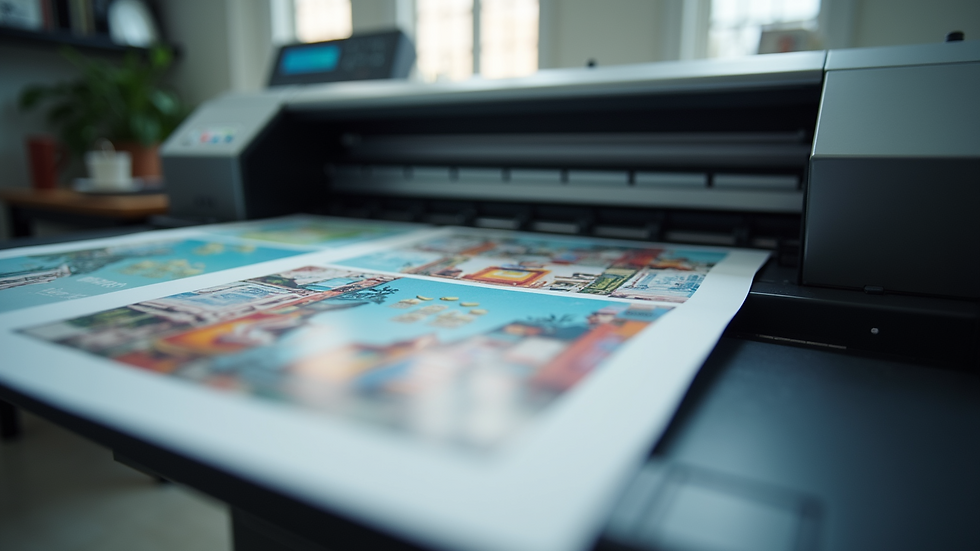Understanding the Process Behind Custom Printing Services
- Gruv Designs

- Oct 24
- 3 min read
Custom printing services have revolutionized the way businesses and individuals create personalized products. From promotional items to unique gifts, custom printing allows for creativity and branding to come together seamlessly. But what exactly happens behind the scenes? Understanding the process can help you make better decisions when ordering custom printed products and ensure you get the best results.
What Is Custom Printing?
Custom printing refers to the process of producing printed materials or products tailored to specific designs, logos, or messages. Unlike mass-produced items, custom printing allows for unique personalization, making each product distinct.
There are various types of custom printing methods, including:
Screen Printing: Ideal for bulk orders, this method uses stencils and ink to transfer designs onto surfaces.
Digital Printing: Perfect for small runs and detailed images, digital printing uses inkjet or laser technology.
Heat Transfer Printing: Designs are printed on special paper and then transferred to the product using heat.
Embroidery: Though not printing per se, embroidery is often offered alongside custom printing for fabric products.
Each method has its advantages depending on the material, quantity, and design complexity.

How Custom Printing Works: Step-by-Step
Understanding the workflow of custom printing can help you communicate your needs clearly and avoid common pitfalls.
1. Design Creation
The process begins with the design. You can provide your own artwork or work with a designer to create something unique. It’s important to use high-resolution images and vector files when possible to ensure clarity.
2. Material Selection
Choosing the right material is crucial. Whether it’s t-shirts, mugs, bags, or corporate gifts, the material affects the printing method and final look. For example, cotton is great for screen printing, while polyester works well with sublimation.
3. Proofing and Approval
Before production, a proof or sample is created. This step allows you to see how the design will look on the product and make any necessary adjustments.
4. Printing Production
Once approved, the printing process begins. Depending on the method, this can take from a few hours to several days.
5. Quality Check and Packaging
After printing, each item is inspected for quality. Any defects are addressed before packaging and shipping.
This structured approach ensures that the final product meets expectations and maintains high quality.

Choosing the Right Custom Printing Service
Selecting the right provider is key to a successful project. Here are some factors to consider:
Experience and Expertise: Look for companies with a proven track record in your desired printing method.
Range of Products: A diverse product catalog allows you to explore different options.
Turnaround Time: Ensure their production schedule aligns with your deadlines.
Customer Support: Responsive communication helps resolve issues quickly.
Pricing and Minimum Orders: Compare costs and minimum order quantities to find the best fit.
Many businesses also offer custom design printing services, which can be a great option if you want professional help with your artwork.
Tips for Getting the Best Results from Custom Printing
To maximize the impact of your custom printed products, consider these practical tips:
Use High-Quality Artwork: Low-resolution images can result in blurry prints.
Choose Colors Wisely: Some colors may not print accurately on certain materials.
Understand the Printing Method: Each method has limitations; for example, screen printing is less effective for complex gradients.
Order Samples: Always request a sample before placing a large order.
Plan Ahead: Custom printing can take time, so avoid last-minute orders.
By following these guidelines, you can ensure your custom printed items look professional and meet your needs.

Exploring Applications of Custom Printing
Custom printing is used across many industries and purposes, including:
Corporate Branding: Promotional items like pens, mugs, and bags help increase brand visibility.
Event Merchandise: Custom t-shirts and souvenirs for conferences, festivals, and sports events.
Personal Gifts: Personalized mugs, photo books, and apparel make memorable presents.
Retail Products: Small businesses can create unique product lines with custom labels and packaging.
Understanding these applications can inspire you to leverage custom printing for your own projects.
Final Thoughts on Custom Printing Services
Custom printing services offer a powerful way to express creativity and promote brands. By understanding the process, choosing the right provider, and following best practices, you can achieve outstanding results. Whether you need a few personalized gifts or a large batch of promotional items, custom printing opens up endless possibilities.
Explore options and start designing today to bring your ideas to life with quality and precision.




Comments